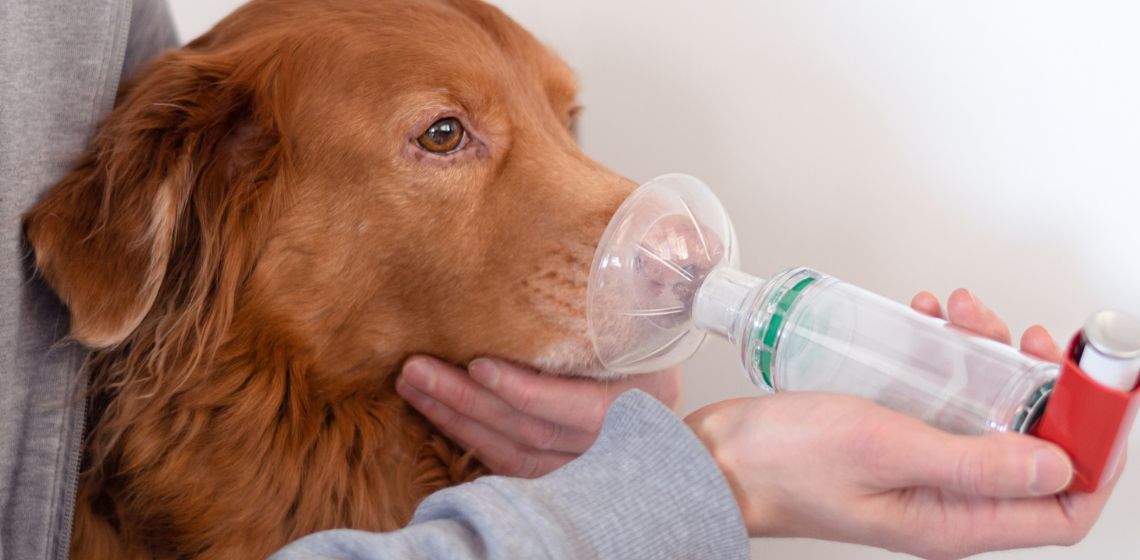Table of Contents
What is asthma?
Asthma in cats and dogs is an inflammatory disease of the airways in the lungs. It is often triggered by an allergic reaction in which the body’s immune system overreacts to inhaled irritants (allergens) like pollen, dust, or smoke, bringing immune cells to the airways. This causes the airways to become irritated, constricted, and filled with excess mucus, making it difficult for the animal to breathe normally.
Causes and triggers of asthma
While the exact cause is unknown, common triggers of asthma in sensitive animals include:
- Pollen
- Dust mites
- Mold
- Cigarette smoke
- Cat litter
- Perfumes or hairsprays
- Household cleaners
- Candles
Additionally, stress, obesity, respiratory infections, and other preexisting medical conditions can exacerbate asthma symptoms. Symptoms may come and go as exposure to triggers waxes and wanes.
Asthma is much more common in cats than dogs, affecting approximately 1 to 5% of felines.
It is mostly diagnosed in cats between the ages of two and eight years of age. Siamese cats seem to be at higher risk. While asthma is a less common cause of respiratory issues in dogs, small middle-aged pups may be most affected.
Symptoms of asthma in dogs and cats
The classic symptoms of feline asthma are:
- Often mistaken for attempts to clear a hairball.
- Wheezing: A whistling or squeaking sound when breathing.
- Labored breathing: Exaggerated effort or open-mouth breathing (while it’s normal for dogs to pant, this is very abnormal for cats and a sign of respiratory distress).
- Episodes of respiratory distress: These can be severe and require urgent veterinary attention.
- Lethargy and bluish gums are due to a lack of oxygen in extreme cases.
- Fever and decreased appetite are NOT usually associated with feline asthma.
Dogs with asthma will show many of the same symptoms. However, there are other medical conditions that are more likely to be causing them, such as infections (kennel cough, pneumonia, etc), heart disease, collapsing trachea, heartworm, or cancer.
Asthma symptoms can range from mild to severe. If your pet is struggling to breathe, it’s crucial to seek emergency veterinary care. For less urgent cases, like persistent coughing with normal breathing, schedule a regular appointment with your vet.
How vets diagnose asthma
To diagnose asthma, your veterinarian will start with a thorough physical examination and assess your pet’s medical history. Initial diagnostic tests usually include:
- Blood tests: These assess overall health. Eosinophils (a type of white blood cell) are often elevated in cases of asthma, allergies, or parasites.
- Heartworm test: Rules out heartworm disease as a cause of respiratory symptoms.
- Chest radiographs (X-rays): Help visualize the lungs and airways, and may show changes characteristic of asthma.
In some cases, further testing may be necessary. This might include fecal tests to check for lung parasites, airway washes to analyze cells and fluid from the lungs, or bronchoscopy with cytology and/or culture. During bronchoscopy, a specialist uses a small, flexible scope to directly view the airways and collect samples for microscopic examination (cytology) or growth of potential microorganisms (culture).
While diagnosing asthma can sometimes be straightforward, it may require more extensive testing. Unfortunately, veterinarians often can’t pinpoint the exact trigger for the asthmatic response.
Treatments of asthma in cats and dogs
While there is no cure for asthma, it can be managed in several ways. The main treatment goals in both cats and dogs are reducing inflammation and opening up the airways. Similar types of medications are used, such as corticosteroids and bronchodilators, but the dosages and forms of medication (inhaled vs. oral) may differ between cats and dogs. Inhalant medications are often used daily, with a rescue inhaler reserved for flare-ups.
- Outpatient vs. Emergency Care: Most cats and dogs with asthma are treated as outpatients. However, if your pet is in severe respiratory distress, hospitalization with oxygen therapy and intravenous medications may be needed for stabilization.
- Managing triggers: Identifying and reducing your pet’s exposure to allergens and irritants is crucial. Consider low-dust litter for cats, eliminating smoke, minimizing dust buildup, using air filters, and paying attention to any environmental changes that might worsen symptoms.
- Importance of weight management: Excess weight worsens systemic inflammation and puts strain on the respiratory system. Helping your pet achieve a healthy weight is an essential part of asthma management.
- Bronchodilators: These medications open up constricted airways for easier breathing. They are often prescribed in inhaled forms (like albuterol/salbutamol) for direct targeting of the lungs.
- Corticosteroids: Potent anti-inflammatory medications, corticosteroids can provide significant relief to pets with asthma by decreasing inflammation in the lungs. They may be given as injections (long-acting), orally, or as inhalants (like fluticasone) to minimize side effects.
- Other: Some pets benefit from a specialized hypoallergenic diet designed to reduce the risk of allergic reactions. While dietary changes take time to show effects, this could potentially decrease long-term medication needs. Additionally, for pets that respond positively, medical acupuncture is a potential way to ease asthma symptoms and reduce the need for certain medications.
How to give inhaled medications to dogs and cats
Inhaled medications are often a cornerstone of asthma treatment for both cats and dogs, as they are safer and have fewer side effects than other types of medication. They also deliver the medication directly to the airways for maximum effectiveness.
It can take some getting used to, but many pet owners are able to easily and successfully medicate their pets with the use of a spacer device (like the AeroKat for cats or AeroDawg for dogs). This is a chamber that attaches to the inhaler, which makes administering inhaled medication much easier for you and your pet. The spacer holds the medication after it’s released from the inhaler, allowing your pet to breathe it in at their own pace.
Steps for administering inhaled medication with a spacer
- Familiarization: Initially, let your pet get used to the spacer device without medication. Hold the mask gently over their face for short periods, offering praise and treats.
- Shake and insert: Shake the inhaler as directed and insert it into the back of the spacer.
- Apply the mask: Gently hold the mask over your pet’s nose and mouth, ensuring a good seal.
- Press the inhaler: Press down on the inhaler once to release a puff of medication.
- Count breaths: Watch your pet’s breathing and count approximately 7-10 breaths to ensure they inhale the full dose.
- Reward: Offer praise and treats to make the experience positive.
Your veterinary team will provide detailed instructions on how to administer your pet’s medications.
Prognosis
Asthma is a manageable condition, but affected pets may have flare-ups from time to time. If your pet shows signs of breathing difficulties, seeking a veterinary assessment is critical. By understanding asthma and working closely with your veterinarian, you can help your furry companion breathe easier and enjoy a better quality of life.
FAQ
Common symptoms of asthma in pets include persistent coughing, wheezing, and labored breathing. Severe signs indicating the need for emergency vet care include respiratory distress, open-mouth breathing in cats, and blue gums.
Asthma in a dog can sound like a mild persistent cough, increased panting, wheezing (a whistling or squeaking sound while breathing), and in severe cases respiratory distress. Asthma is not very common in dogs, so it is important for your vet to rule out other more common causes of these symptoms.
You can help manage your dog’s asthma by identifying and removing allergen triggers and keeping them at a healthy weight. However, the cornerstone of asthma treatment involves steroids and bronchodilators prescribed by your vet. These can be given at home as pills or through an inhaler.

Liza is a veterinarian who graduated from MSU CVM in 2013 and spent five years working in small animal practice. She loved working with dogs and cats and educating owners on all aspects of veterinary medicine, especially animal behavior and dermatology. She has since transitioned to remote work to be able to spend more time at home with her husband, two young kids, and two cats. She is thrilled to be able to combine her passions for veterinary medicine and writing. She is licensed as a veterinarian in Washington State.








